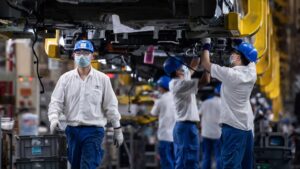The Ripple Effect of Tariffs: What It Means for the Automotive Industry
As the automotive landscape continues to evolve, recent developments in trade policy are casting new shadows over both manufacturers and consumers. On Saturday, former President Donald Trump announced the imposition of a 10% additional tariff on select imports from China, a move anticipated to disrupt the already fragile supply chain within the auto industry. Here at Extreme Investor Network, we delve deeper into the implications of this decision and its potential impact on the economy, automakers, and vehicle prices.
Understanding the Tariff’s Scope
While the new tariffs apply to a limited number of vehicles, the broader ramifications extend to the supply chains that underpin the industry. Notably, auto parts—including critical components sourced from China—are also subject to this tariff. According to the U.S. International Trade Commission, the U.S. imports approximately $15 billion to $17.5 billion worth of transportation goods from China annually, with auto parts alone representing between $9 billion to $10 billion of that figure.
The most affected vehicles will likely be the Ford Lincoln Nautilus and General Motors Buick Envision, two crossovers that together accounted for 95% of the 88,515 China-made vehicles sold in the U.S. last year. "It’s mainly GM and Ford that are really hit from a volume standpoint," remarked Jeff Schuster, Vice President of Automotive Research at GlobalData. This insight emphasizes the vulnerability of American automakers in the face of international trade policies.
Rethinking Trade and Production Strategies
In response to these new tariffs, Ford’s incoming CFO, Sherry House, stated the company would “assess the situation” and evaluate how the tariffs might influence their import and export strategies. While a cautious approach is warranted, the real question is how such tariff changes will alter the production landscape for U.S. manufacturers.
Interestingly, automakers like Volvo and its electric vehicle spin-off Polestar have begun adjusting production plans to minimize China-sourced components, particularly in light of existing tariffs on EV imports from China.
The Economic Consequences
The potential economic fallout from these tariffs goes beyond immediate price increases. Currently, China-made vehicles account for only 0.6% of the estimated 16 million new vehicles sold in the U.S. in 2024. However, the situation is precarious; should tariffs extend to trade partners such as Canada or Mexico—who accounted for over 23% of U.S. car sales last year—the repercussions would be far more severe.
Notably, analysts like Mark Delaney from Goldman Sachs are closely monitoring the situation, as China plays a vital role in the battery supply chain, particularly for electric vehicles. Many electrified vehicles sold in the U.S. contain a significant percentage of components from China. For example, Hyundai’s Kona EV sources 50% of its parts from Chinese manufacturers. The increasing costs from tariffs on critical components will likely trickle down to consumers, potentially driving prices for new vehicles even higher.
A Costly Dilemma for Consumers
With new vehicle prices already hovering around a historic average of $50,000, any additional costs passed on to consumers could stifle sales. Economic analysts from S&P Global Mobility predict a decline in new vehicle sales from an anticipated 16.2 million to potentially lower figures if tariffs continue to influence pricing strategies.
Stephanie Brinley, a principal automotive analyst, noted, “There’s not a specific item from China under this tariff that says, ‘Oh, no, this is going to mess everything up’ … but they will drive up costs.”
What does this mean for consumers? Elevated prices could deter potential buyers, especially as wholesalers find themselves in a tightening market.
Conclusion: A Complex Landscape
In these turbulent times, it’s essential for both investors and consumers to stay informed. The automotive industry is navigating uncharted waters as it faces challenges from tariffs, supply chain disruptions, and pricing volatility. Here at Extreme Investor Network, we strive to equip our readers with the insights and analysis needed to understand these dynamics and make informed decisions. As the industry continues to evolve, keeping a close eye on policy changes and their economic implications will be critical for all stakeholders involved.
Stay tuned for further updates and insights into the automotive market and its interconnectedness with global trade.

